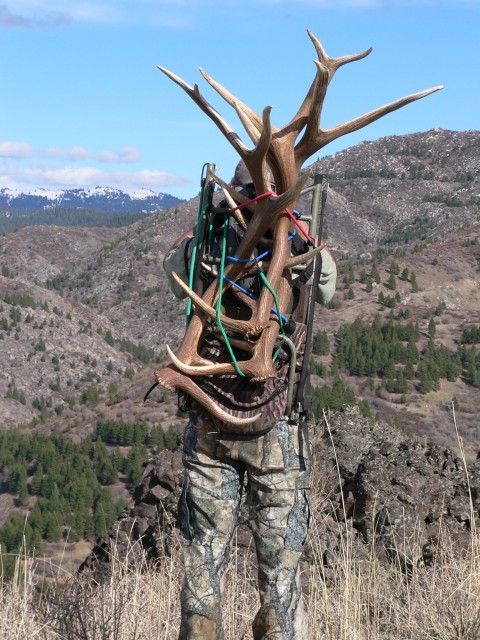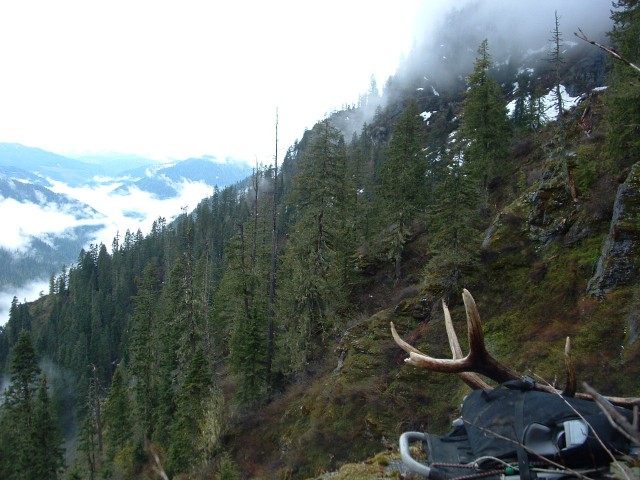Shed Antler Tactics
 Itching to Get Out?
Itching to Get Out?
Ooh here we go! This is one of my favorite times of the year. The snow is steadily melting, the streams are rising, hillsides are getting greener everyday and as you read this a fresh brown elk shed is probably hitting the ground. There are several reasons to get out and hit the hills to look for elk sheds. Scouting, exercise, and just for the love of spotting an antler to bring home and add to the pile. Shed hunting is really not an exact science and success boils down to one main thing – “Time”. Time is one of our greatest enemies these days, and before we know it another shed hunting season will have come and gone.
I spend 4 to 5 days in the hills looking for elk sheds annually anymore (used to be 14 or 15). This lack of time has increased my focus on becoming a smarter, more efficient shed hunter. Even though I just enjoy getting out it is nice to come home with some bone. Here are a few tactics to keep in mind that may make you a more efficient shed hunter.
Slow Down!
I used to go as fast as I could to get to that one trusty bench that was 5 miles from anywhere just because I knew that bench would hold at least one antler. What I didn’t realize is that I walked by 5 just to get that one antler. Now I will get to the elevation where there is a lot of elk sign and look behind every bush. I will simply slow down and zig zag the terrain until I have covered an entire area thoroughly. This way if I have time to come back to the same drainage, I can avoid the exact same slopes and focus on different places within that drainage. I found that when I did not pattern where I have been it becomes difficult to remember unless you are in more open ground with good landmarks.
Find the food source.
 In most cases the food source is the green vegetation that is popping out of the ground this time of the year at lower elevations. As the snow leaves an area, it is not long before the green grass starts to appear. If elk are left alone they will travel miles often descending from higher elevations to get this fresh green vegetation. As the snow line rises so does the food source and elk will follow. Find this annual travel pattern and follow it, as it will lead you to the antlers. Also look for windswept ridges or bluffs in higher elevations. These areas seem to have their own little micro-habitat and produce good early food sources for elk. The bluffs have areas protected from the weather where moss and other potential food sources lie uncovered. These are constant food sources throughout the winter and especially in late winter and early spring. These bluffs in the mid elevation ranges always seem to hold a good number of elk and small bachelor groups of bulls.
In most cases the food source is the green vegetation that is popping out of the ground this time of the year at lower elevations. As the snow leaves an area, it is not long before the green grass starts to appear. If elk are left alone they will travel miles often descending from higher elevations to get this fresh green vegetation. As the snow line rises so does the food source and elk will follow. Find this annual travel pattern and follow it, as it will lead you to the antlers. Also look for windswept ridges or bluffs in higher elevations. These areas seem to have their own little micro-habitat and produce good early food sources for elk. The bluffs have areas protected from the weather where moss and other potential food sources lie uncovered. These are constant food sources throughout the winter and especially in late winter and early spring. These bluffs in the mid elevation ranges always seem to hold a good number of elk and small bachelor groups of bulls.
Make the sacrifice!
To the “Horn Gods” that is. Your first old antler of the day must be picked up and thrown as far as possible and left as it lies. This is the only sure-fire technique that I have found that has brought me the luck of finding a good brown shed. Leave a few for the critters to chew on and you will be rewarded. There are enough to go around.
This is an excellent time of the year to get the entire family out to hike around with hopes of finding elk sheds. Please remember to always enjoy just being out there and not to get too greedy. This is a crucial time of year for elk while they are recovering from the winter elements. Try not to jump the gun and push them out of their valuable food source. Be patient and just be happy to be out there. Good luck to everyone this spring and be sure to send in photos. See you on the slopes!
